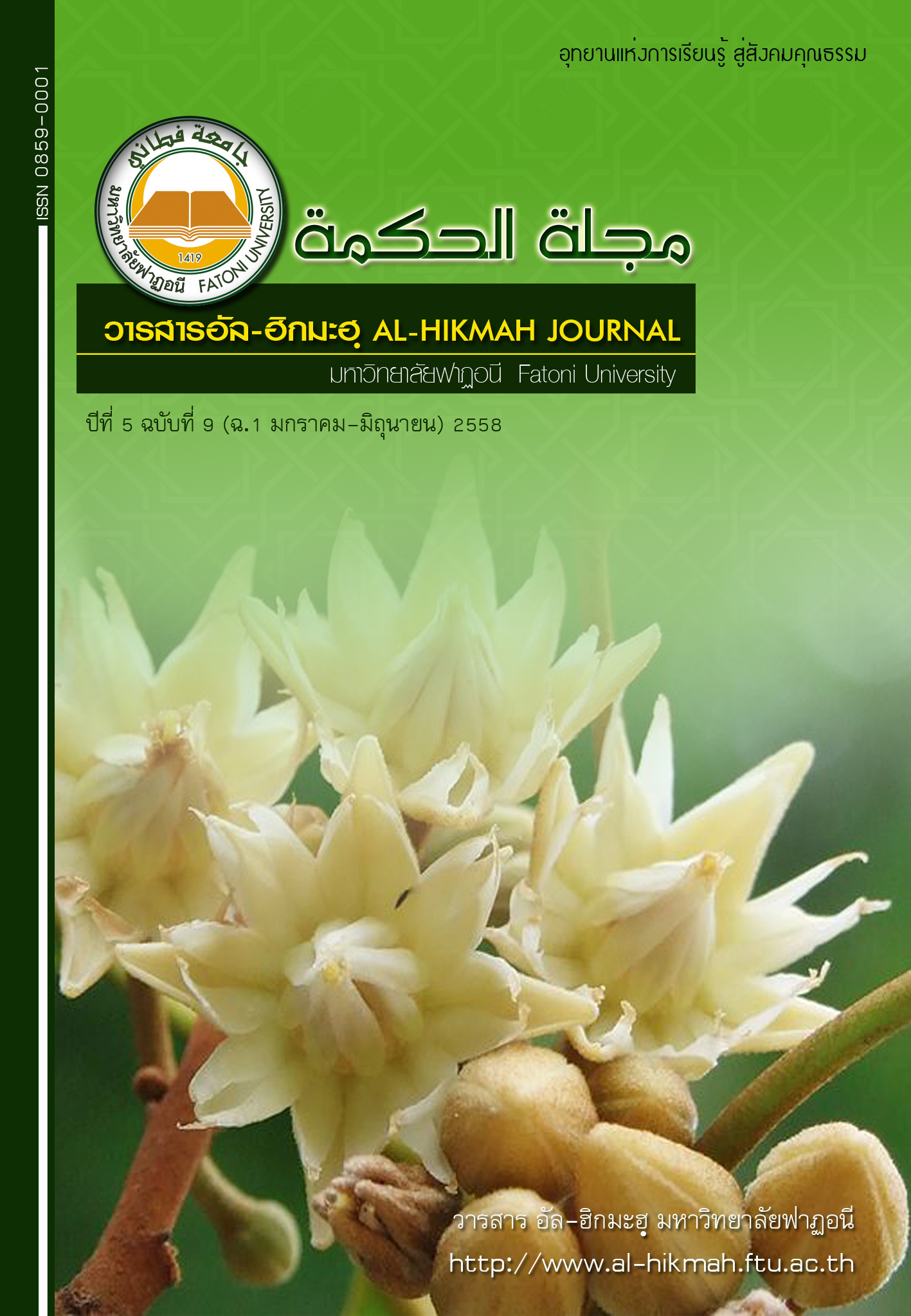Aggressive Behaviors among Male Inmates: A Case Study of a Government Prison
Keywords:
aggressive behaviors, male inmates, prisonAbstract
This descriptive research aimed to investigate levels of male inmate aggressive behaviors. One hundreds and seventy-five male inmates, attending a government prison, in one province, mid-southern Thailand, were recruited into the study. Convenience sampling technique was used to indicate the subject sample. A close-ended aggression behavior questionnaire, validated by 3 expert raters, was used for data collecting, through self-reported questionnaire survey. Reliability test was computed, using Cronbach’s alpha coefficient, yielding the value of 0.95 for aggressive behaviors. Data was analyzed by using descriptive statistics analysis: frequency, percentage, mean, and standard deviation.
Results showed that a mean score of overall level of aggressive behaviors was at a high level, that is, = 2.59 (sd = 0.55). Considering each aspect of the aggressive behaviors, all the mean scores for each aspect were at high levels as well: use of physical force, = 2.64 (sd = 0.63); negativism, = 2.62 (sd = 0.63); indirect action, = 2.59 (sd = 0.60); mood instability, = 2.55 (sd = 0.62); and verbal aggression, = 2.54 (sd = 0.62), respectively.
These findings might be applicable to planning for a better care of male inmates, by promoting cozy environment with least stressful conditions in prison.
References
ชูศรี วงศ์รัตนะ. 2544. เทคนิคการใช้สถิติเพื่อการวิจัย. ฉบับปรับปรุง ครั้งที่ 7. กรุงเทพฯ: ศูนย์หนังสือจุฬาลงกรณ์มหาวิทยาลัย.
ดวงตา ไกรภัสสร์พงษ์. 2544. ความผิดปกติทางจิตเวชของผู้ต้องขัง:การศึกษาในเรือนจำเขต กรุงเทพมหานครและเรือนจำบางขวาง. กรุงเทพมหานคร: โรงพยาบาลนิติจิตเวช สุขภาพจิต กระทรวงสาธารณสุข
ทิพรัตน์ เฮงตระกูล. 2540. ผลการให้คำปรึกษาแบบกลุ่มตามทฤษฎีการใช้เหตุผลและอารมณ์เพื่อลดพฤติกรรมก้าวร้าวของนักเรียนชั้นมัธยมศึกษาปีที่ 4 โรงเรียนสระแก้ว จังหวัดสระแก้ว. มหาบัณฑิต สาขาจิตวิทยาการ
แนะแนว บัณฑิตวิทยาลัย มหาวิทยาลัยบูรพา.
นิรมล ธรรมเจริญ. 2545. ความพร้อมของหัวหน้าฝ่ายทัณฑปฏิบัติและหัวหน้าฝ่ายจำแนกลักษณะของผู้ต้องขังในการจำแนกลักษณะของผู้ต้องขัง.วิทยานิพนธ์ปริญญาสังคมสงเคราะห์ ศาสตรมหาบัณฑิต สาขาวิชาอาชญ
วิทยาและงานยุติธรรมบัณฑิตวิทยาลัยมหาวิทยาลัยมหิดล.
พัชราภรณ์ เวชวงศ์วาน. 2532. ผลกระทบของการถูกจองจำต่อผู้ต้องขัง.วารสารราชทัณฑ์, 37 (4), 18-23.
วรรณรัตน์ ศรีสุวรรณ. 2536. การให้คำปรึกษาแบบกลุ่มเพื่อลดพฤติกรรมก้าวร้าวของนักศึกษาชั้นปีที่ 1 คณะเกษตรศาสตร์ บางพระ ชลบุรี. วิทยานิพนธ์มหาบัณฑิต สาขาจิตวิทยาการแนะแนว บัณฑิตวิทยาลัย มหาวิทยาลัยบูรพา.
สถาบันกัลยาราชนครินทร์. 2546. รายงานการวิจัยภาวะสุขภาพจิตของนักโทษคดีความผิดต่อชิวิตและร่างกาย. กรุงเทพมหานคร: บี ยอนด์ พับลิสซิ่ง จำกัด.
เอมอร เสียงใหญ่. 2541. การศึกษาการเตรียมความพร้อมให้แก่ผู้ต้องขังเพื่อกลับเข้าสู่สังคมปกติ.วิทยานิพนธ์ปริญญาสังคมสงเคราะห์ศาสตรมหาบัณฑิต สาขาอาชญวิทยาและงานยุติธรรม
บัณฑิตวิทยาลัย มหาวิทยาลัยมหิดล.
Ang RP. 2007. Factor structure of the 12-item aggression questionnaire: further evidence from Asian adolescent samples.J Adolesc. Aug; 30(4): 671-85.
Gerevich J, Bacskai E, Czobor P. 2007. The Generalizability of the Buss-Perry Aggression Questionnaire. Int.J Methods Psychiatr Res.; 16(3): 124-36.
Hage S, Van Meijel B, Fluttert F, Berden GF. 2009. Aggressive behaviour in adolescent psychiatric settings: what are risk factors, possible interventions for nursing practice? A literature review. J
Psychiatr Ment Health Nurs. Sep; 16(7): 661-9.
Harris F, Hek G, and Condon L. 2006. Health needs of prisoners in England and Wales: the implications for prison health care of gender, age, and ethnicity. Health and Social Care in the Community, 15(1): 56-66.
Levitt L. and Loper AB. 2009. The influence of religious participation on the adjustment of female inmates. Am J Orthopsychiatry. Jan; 79(1): 1-7.
Meehan T, McIntosh W, and Bergen H. 2006. Aggressive behaviour in the high-secure forensic setting: the perceptions of patients. J Psychiatr Ment Health Nurs. Feb; 13(1): 19-25.
Smith, A.K. 1999. Theories of Aggression. Retrieved May 10, 2007, from
http://seredip.brynmawr edu/bb/neuro/neuro99/web3/Sith.html
Workman DG. and Cunningham DG. 1975. Effect of psychotropic drugs on aggression in prison setting. Canadian Family Physician. November: 63-66.



